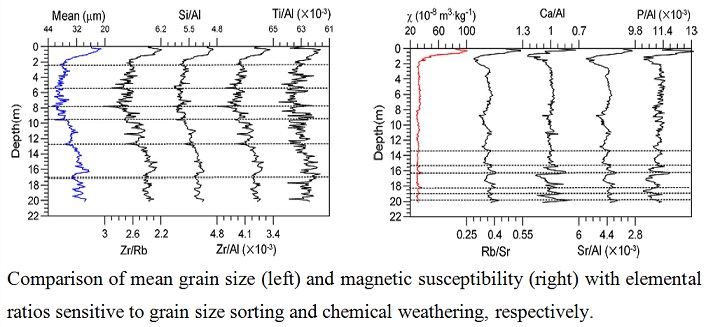IEECAS Applied Elemental Ratios to Infer Grain Size Sorting and Chemical Weathering
Major and trace elemental compositions of loess samples collected from the Jingyuan section in the northwestern Chinese Loess Plateau (CLP) were analyzed to investigate the potential impacts of grain size sorting and chemical weathering on the loess geochemistry and to extract appropriate geochemical indices for better evaluating the East Asian monsoon variability. Based on variations of major and trace elements in different grain size fractions, seventeen elements were classified into three types: (1) Si and Na display higher contents with the increased particle sizes; (2) Al, Fe, Mg, K, Mn, Zn, Rb, Cr, V are mainly enriched in fine size fractions; (3) Ti, Ba, Zr, P, Ca and Sr show irregular variations among different size fractions. Comparison of Al-normalized elemental ratios with Zr/Rb and Rb/Sr ratios (two commonly employed indicators for grain size sorting and pedogenic weathering) indicates that Si/Al, Zr/Al, Ti/Al variations match well with Zr/Rb and grain size results, whilst Ca/Al, Sr/Al, P/Al ratios display similar variability as that of Rb/Sr ratio. Comparison of loess based proxies (e.g., elemental ratios, magnetic susceptibility, grain size) of Jingyuan section with speleothem and ice-core records confirms that elemental ratios of high-resolution loess sequences developed in the northwestern CLP can be employed to address fluctuations of the winter monsoon-induced grain size sorting and summer monsoon-related weathering and pedogenesis at glacial–interglacial and millennial timescales.

Paper link:
 © 2015 Institute of Earth Environment,CAS
© 2015 Institute of Earth Environment,CAS Address:No. 97 Yanxiang Road, Xi'an 710061, Shaanxi, China

 Location :
Location :